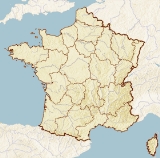
Guyencourt-sur-Noye
Encyclopedia
Guyencourt-sur-Noye is a commune
in the Somme
department in Picardie
in northern France
.
, some 10 miles (16 km) south of Amiens
.
Prehistoric flint
tools have been found in the vicinity
Communes of France
The commune is the lowest level of administrative division in the French Republic. French communes are roughly equivalent to incorporated municipalities or villages in the United States or Gemeinden in Germany...
in the Somme
Somme
Somme is a department of France, located in the north of the country and named after the Somme river. It is part of the Picardy region of France....
department in Picardie
Picardie
Picardy is one of the 27 regions of France. It is located in the northern part of France.-History:The historical province of Picardy stretched from north of Noyon to Calais, via the whole of the Somme department and the north of the Aisne department...
in northern France
France
The French Republic , The French Republic , The French Republic , (commonly known as France , is a unitary semi-presidential republic in Western Europe with several overseas territories and islands located on other continents and in the Indian, Pacific, and Atlantic oceans. Metropolitan France...
.
Geography
The commune is situated on the D116 road, by the banks of the river NoyeNoye
The Noye is a river in the Picardie region of northern France.The Noye is located in the northern part of the Picard plateau. It is the left tributary of the Avre river, which is itself a left tributary of the Somme River. The Noye starts near the commune of Vendeuil-Caply and extends to a length of...
, some 10 miles (16 km) south of Amiens
Amiens
Amiens is a city and commune in northern France, north of Paris and south-west of Lille. It is the capital of the Somme department in Picardy...
.
History
In 1692, the village name was written as Guiencourt.Prehistoric flint
Flint
Flint is a hard, sedimentary cryptocrystalline form of the mineral quartz, categorized as a variety of chert. It occurs chiefly as nodules and masses in sedimentary rocks, such as chalks and limestones. Inside the nodule, flint is usually dark grey, black, green, white, or brown in colour, and...
tools have been found in the vicinity

